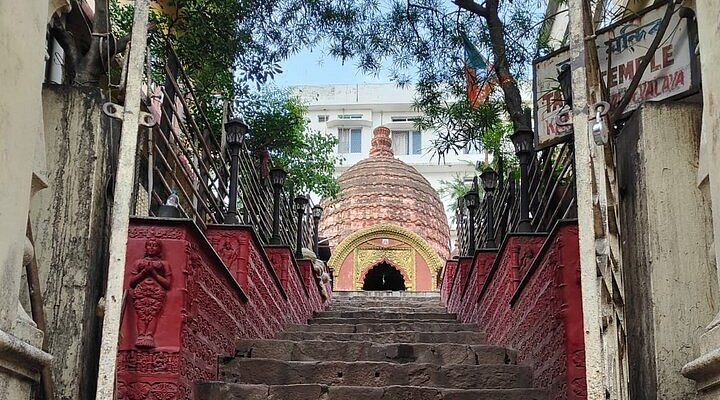When you think of Varanasi, images of the Ganga aarti, ancient ghats, and the endless ringing of temple bells probably come to mind. But tucked away in the busy lanes of this city is a place that feels different—quieter yet more powerful, mysterious yet welcoming. I’m talking about the Mahamrityunjay Temple, one of Varanasi’s most revered shrines, dedicated to Lord Shiva in his life-protecting form.
On my visit to this temple, I realized it wasn’t just another stop on Varanasi’s long list of holy places—it was an experience that touched something deeper. Let me take you along with me as we explore the legends, the rituals, the vibe, and everything you should know if you’re planning to visit.
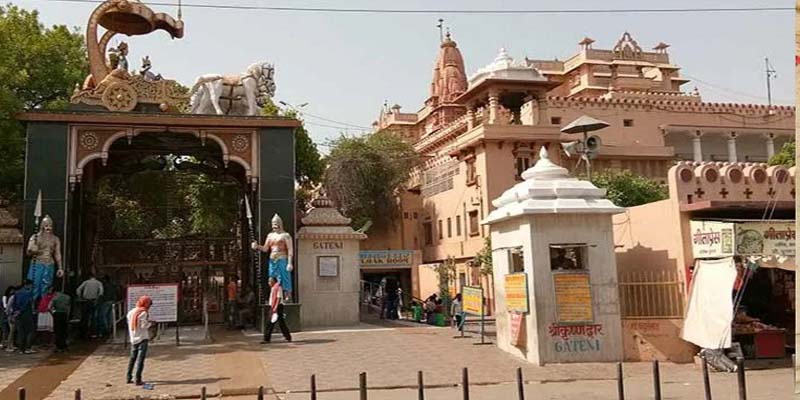
Why This Temple is So Special
The very name Mahamrityunjay reveals the depth of devotion associated with this temple. It comes from the Mahamrityunjaya Mantra, one of the most revered chants in Hinduism, often called the death-conquering mantra. For centuries, devotees have recited it during times of illness, crisis, or uncertainty. The mantra is believed to offer protection from untimely death, to heal the body and mind, and to grant a life filled with peace and longevity.
When you stand inside the Mahamrityunjay Temple, these beliefs don’t feel like distant stories—they seem to live and breathe within the walls. Every corner hums with whispered chants, the smell of incense, and the quiet determination of people who come here with their deepest fears and highest hopes.
The Living Power of the Lingam
At the heart of the temple rests the Shiva Lingam, an ancient symbol of Lord Shiva’s presence. What makes this lingam unique is that it is constantly bathed in water, not through pipes or human effort but by a natural underground stream. This continuous flow is more than just a curious geological feature—it is a sacred symbol of life itself.
Locals told me that no matter how hot the summer sun burns, the lingam never dries up. The water never stops. For them, this unbroken stream represents the eternal cycle of healing and protection offered by Shiva. It’s as if nature itself conspires to keep the temple alive with energy.
When I placed my hand on the stone, it felt cool, soothing—almost like touching the calm heartbeat of the earth. That simple sensation stays with you long after you leave.
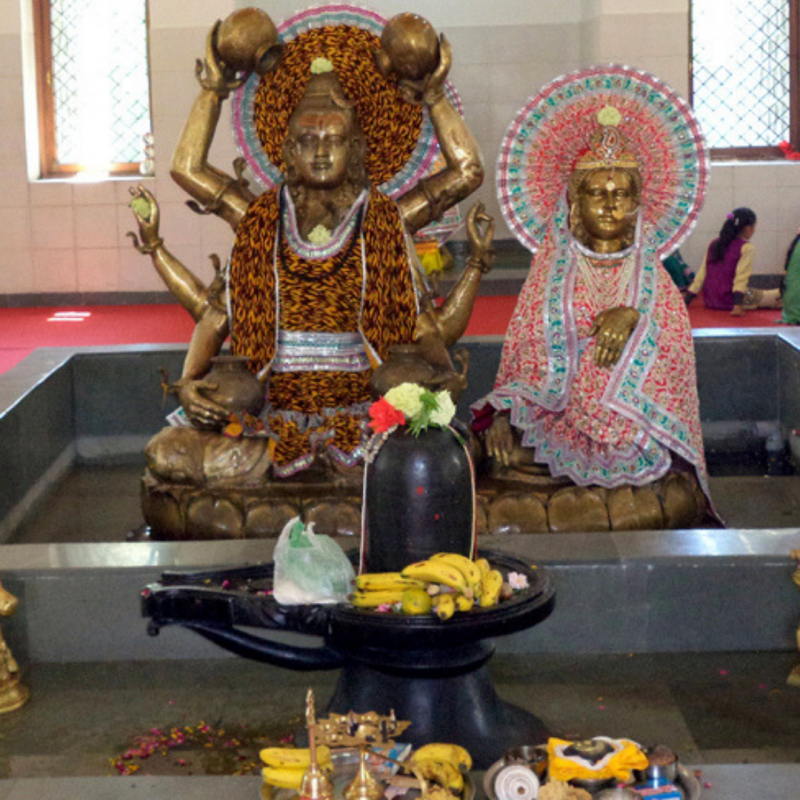
Faith in Everyday Life
For the people of Varanasi, the Mahamrityunjay Temple is not just another shrine on the city’s spiritual map—it is part of daily life. Families bring their sick loved ones here, hoping the water and prayers will ease suffering. Young couples pray for a long, harmonious life together. Travelers and pilgrims stop to chant the mantra, even if just once, before moving on to other temples in the city.
There’s a saying among locals that offering prayers here not only removes negativity but also strengthens your inner resilience. Whether or not you believe in miracles, you cannot deny the comfort people find in this place. It’s almost as though the temple offers an invisible shield, a quiet assurance that whatever storms life throws at you, you are not alone.
More Than Myth
While legends and beliefs form the foundation, what truly struck me was the human experience surrounding the temple. The elderly priest who patiently ties sacred threads around people’s wrists, the young student lighting a lamp before his exams, the mother whispering the mantra for her child’s health—these everyday acts transform the temple into a living, breathing sanctuary of hope.
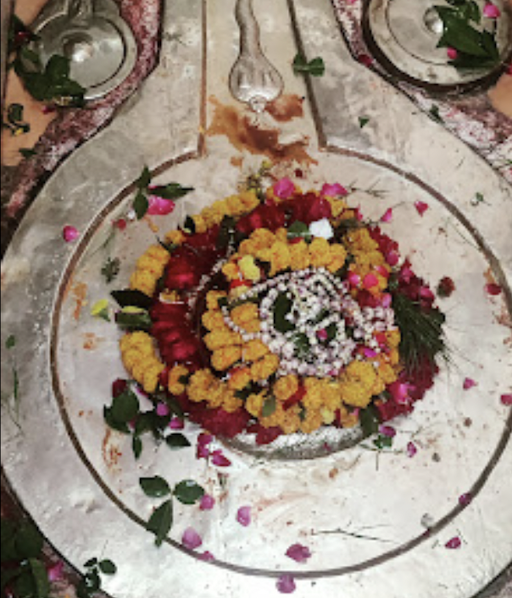
First Impressions – Walking Through the Lanes
Reaching the temple was part of the adventure. Like most places in Varanasi, you don’t just drive up to the gate. You weave through narrow alleys, passing vegetable sellers, cows unbothered by the crowd, and chai stalls where conversations never seem to end. The soundscape changes as you get closer—louder bells, the chanting of mantras, and the occasional conch shell being blown.
The temple itself isn’t massive like the Kashi Vishwanath Temple. Instead, it feels humble, approachable, and deeply rooted in tradition. Its structure is simple, with a stone courtyard and colorful decorations. But what struck me most was the energy inside—devotees moving in rhythm, priests chanting verses, and the smell of incense mixing with fresh flowers.
Rituals and Worship
Visiting Mahamrityunjay Temple is a deeply participatory experience. Unlike some temples where you only watch from afar, here you’re encouraged to offer prayers directly.
- Abhishek (ritual bathing): Devotees pour water or milk over the lingam, symbolizing purification. Many bring holy Ganga water in small pots, collected from the ghats.
- Offering Bilva leaves and flowers: Essential in Shiva worship, these are offered while chanting the Mahamrityunjaya Mantra.
- Lighting lamps and incense: Creating an atmosphere of warmth and devotion.
- Special Tuesdays and Sundays: These days see a larger gathering as they’re considered especially auspicious for Shiva.
On Mondays—the day dedicated to Lord Shiva—the temple is at its busiest. I visited on a Monday morning and found the line stretching outside, yet there was a sense of calm in the chaos. Everyone seemed patient, as if the very act of waiting was part of the prayer.
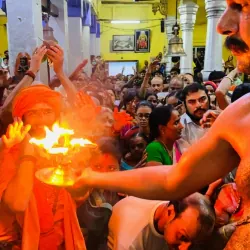
The Power of the Mahamrityunjaya Mantra
It’s impossible to talk about this temple without mentioning the mantra it’s named after. The Mahamrityunjaya Mantra is believed to have been revealed to Rishi Markandeya, who himself was saved from Yama, the god of death, by Lord Shiva’s grace.
Priests often chant the mantra continuously in the temple, especially for devotees performing special pujas. Sitting inside, listening to the rhythmic repetition, I felt an almost hypnotic calm. You don’t need to know the meaning to feel its impact—the vibrations seem to work directly on your spirit.
Many pilgrims also get specific rituals performed here when someone in their family is unwell or going through difficult times. The belief is strong: prayers at this temple have the power to change destiny.
Festivals That Bring the Temple Alive
While the temple is active year-round, festivals are something else entirely.
- Mahashivaratri: The biggest celebration here, with night-long prayers, music, and thousands of devotees pouring in.
- Shravan Month (July–August): Dedicated to Lord Shiva, this month sees daily processions, special abhisheks, and queues stretching into nearby streets.
- Kartik Purnima: Another auspicious time, when lamps are lit across the temple and nearby ghats.
During these times, the temple transforms into a vibrant, living celebration of devotion. If you’re comfortable with crowds and want to feel the pulse of faith in Varanasi, visiting during a festival will be unforgettable.
Nearby Attractions
One of the best things about visiting Mahamrityunjay Temple is that it doesn’t exist in isolation. Varanasi is a layered city—every street corner has a shrine, every ghat has a story, and every lane leads to something unexpected. So when you step out of the temple after offering prayers, don’t just rush back to your hotel. Take the time to wander, explore, and soak in the spirit of Kashi.
Here are the nearby attractions you should not miss, each offering its own unique charm.
1. Kashi Vishwanath Temple – The Spiritual Crown of Varanasi
Just a short walk away from Mahamrityunjay Temple lies the Kashi Vishwanath Temple, the heart and soul of Varanasi. Dedicated to Lord Shiva, this is one of the Twelve Jyotirlingas and perhaps the most sacred for Hindus.
Walking to Kashi Vishwanath from Mahamrityunjay is an experience in itself—you pass through narrow lanes known as Vishwanath Gali, buzzing with shops selling sweets, brassware, religious items, and of course, the famous Banarasi silk sarees.
Why visit?
- To witness the grandeur of daily rituals like the Mangala Aarti at dawn and Shringar Aarti in the evening.
- To feel the magnetic pull of faith—thousands of devotees come here daily, yet somehow you feel like the Lord has time just for you.
- To simply stand inside and know you are in one of the most important spiritual centers of India.
Traveler Tip: The temple has tight security checks, so carry only essentials—no phones, no cameras. Lockers are available outside.
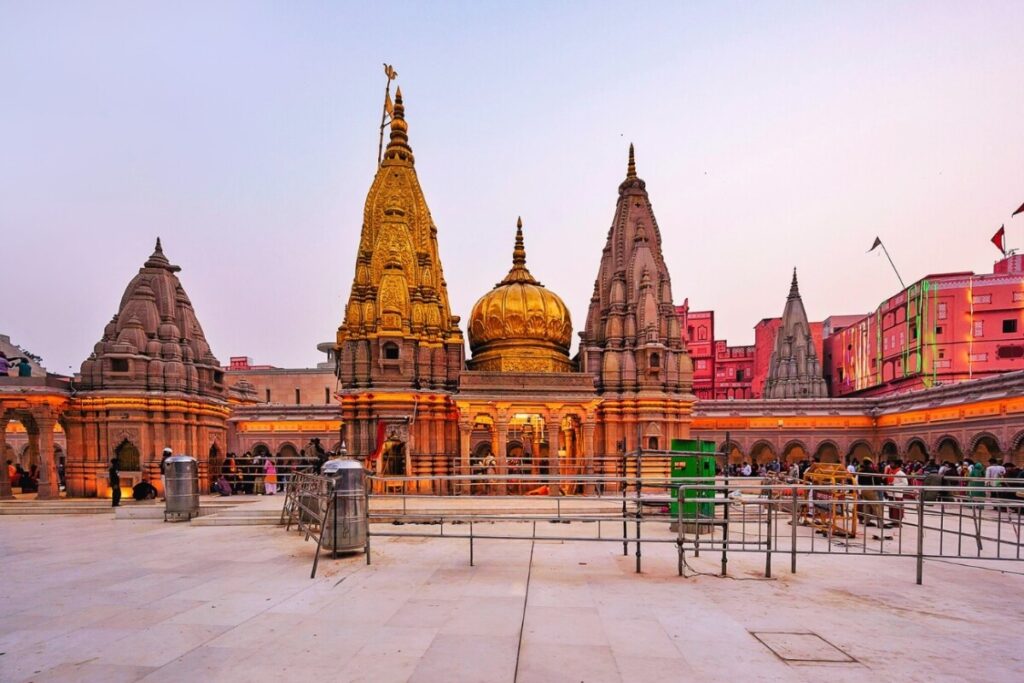
2. Kaal Bhairav Temple – The Guardian of Kashi
If Mahamrityunjay Temple protects devotees from untimely death, then Kaal Bhairav Temple ensures that everyone who enters Varanasi stays under divine protection. Dedicated to a fierce form of Shiva, Kaal Bhairav is believed to be the Kotwal (police chief) of Kashi. The belief is that you cannot truly stay in Varanasi without his permission.
Inside the temple, the deity is represented not as a lingam but as a striking idol with a garland of skulls. Devotees offer black cloth, oil, and flowers.
Why visit?
- To experience the fierce yet protective energy of Shiva.
- To see a different, less serene but more powerful aspect of faith.
- To understand why locals never leave the city without first bowing before Kaal Bhairav.
Nearby Tip: Just outside, you’ll find tiny shops selling everything from garlands to pooja samagri. I recommend stopping for chai at one of the stalls—it’s strong, sweet, and gives you energy for more exploring.’
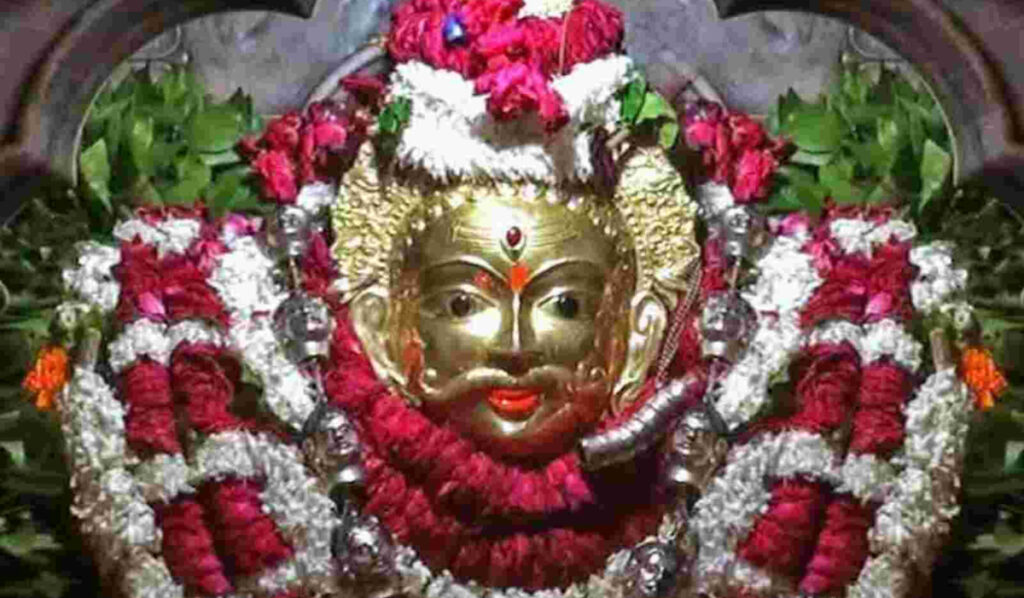
3. Dashashwamedh Ghat – Where the Ganga Comes Alive
No trip to Varanasi is complete without experiencing the evening Ganga Aarti at Dashashwamedh Ghat. It’s just about a 15–20 minute walk from Mahamrityunjay Temple, and I promise, the walk itself is part of the adventure.
The ghat is always lively—sadhus sitting in meditation, boats lining up to take visitors on rides, and pilgrims bathing in the sacred river. But come sunset, everything changes. Priests dressed in saffron and gold line up with huge lamps, conches are blown, bells ring, and chants fill the air.
Why visit?
- The Ganga Aarti is a once-in-a-lifetime experience. Watching hundreds of lamps being waved in unison is simply mesmerizing.
- To take a boat ride either at sunrise or during the evening aarti for a completely different perspective of the ghats.
- To feel the energy of a crowd united in devotion—it’s powerful, emotional, and unforgettable.
Tip: Arrive early (by 5:30 pm) if you want a good view of the aarti. Or better yet, book a seat on a boat for the best vantage point.
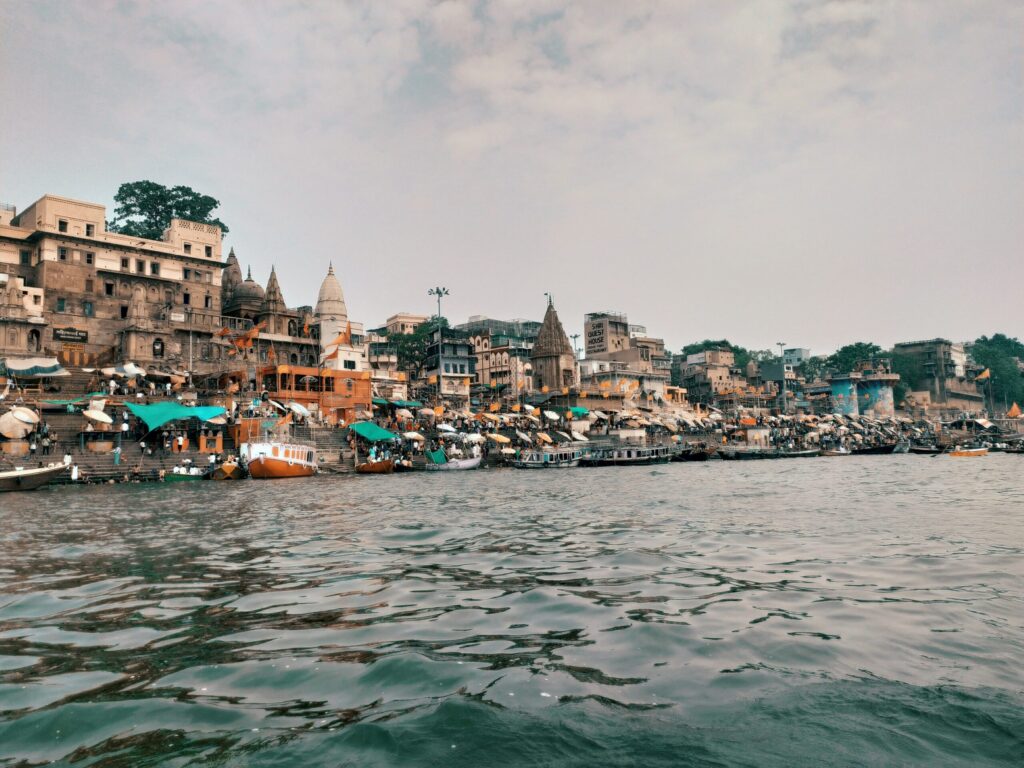
4. Assi Ghat – A Quieter Slice of Varanasi
If Dashashwamedh is the dramatic face of Varanasi, Assi Ghat is its calmer, gentler side. Situated a little further away, it’s still accessible after your temple visits. Many travelers, especially younger crowds and international visitors, love hanging out here.
Why visit?
- Morning yoga sessions and Ganga aarti give a peaceful start to the day.
- Cafes around Assi Ghat serve excellent chai, lassi, and even continental breakfasts.
- Street performances and cultural programs often take place here.
When I visited, I sat down with a steaming glass of Banarasi chai and just watched the river flow. After the intensity of temple visits, Assi Ghat felt like a place to breathe and process everything.
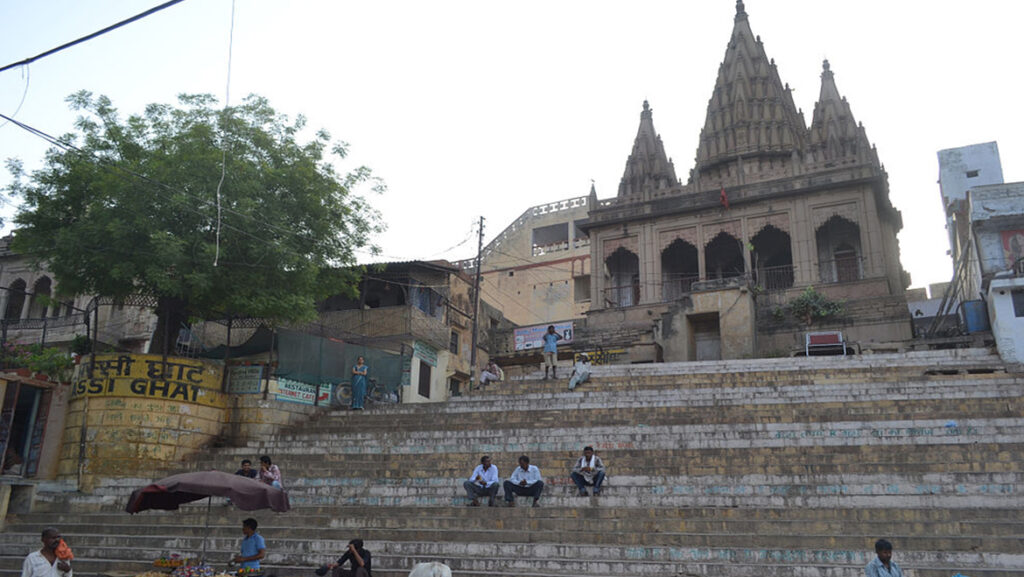
5. Manikarnika Ghat – The Cycle of Life and Death
This may not be for everyone, but Manikarnika Ghat, the main cremation ghat of Varanasi, is both sobering and profound. It’s believed that those who are cremated here achieve moksha—liberation from the cycle of birth and death.
Why visit?
- To understand Varanasi’s deep relationship with life and death.
- To witness rituals that are as old as time.
- To experience spirituality not as something distant, but as an everyday reality.
Note: Be respectful. Don’t take photographs, don’t stare, and if you’re sensitive, you might choose to skip entering the ghat itself and instead observe from a boat on the river.
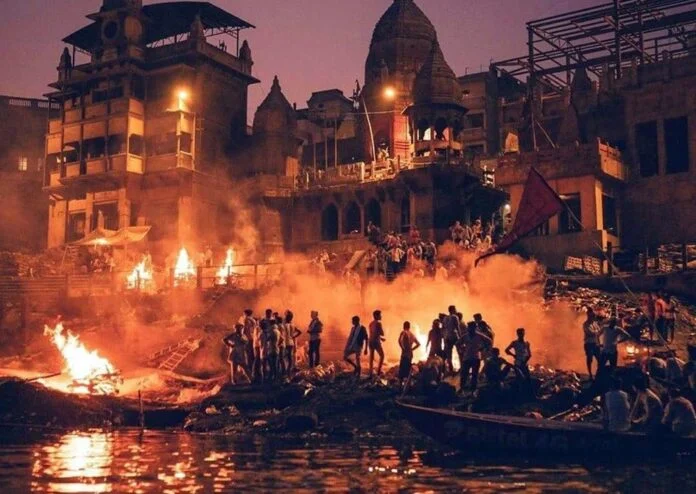
6. Vishwanath Gali – Shopping and Street Food Paradise
After temple visits, you’ll definitely want to indulge in Varanasi’s legendary food and pick up souvenirs. The Vishwanath Gali is the perfect place. This narrow street is lined with shops selling:
- Banarasi silk sarees (a must-buy if you love textiles).
- Rudraksha malas, brass diyas, and idols.
- Street food like kachori-sabzi, jalebis, and malaiyyo (a winter specialty).
On my last trip, I had the crispiest kachoris here, dipped in spicy aloo curry, followed by piping hot jalebis. The flavors still make me smile whenever I think of it.
Tip: Bargain politely when shopping for sarees and handicrafts. And come hungry—you won’t regret it!
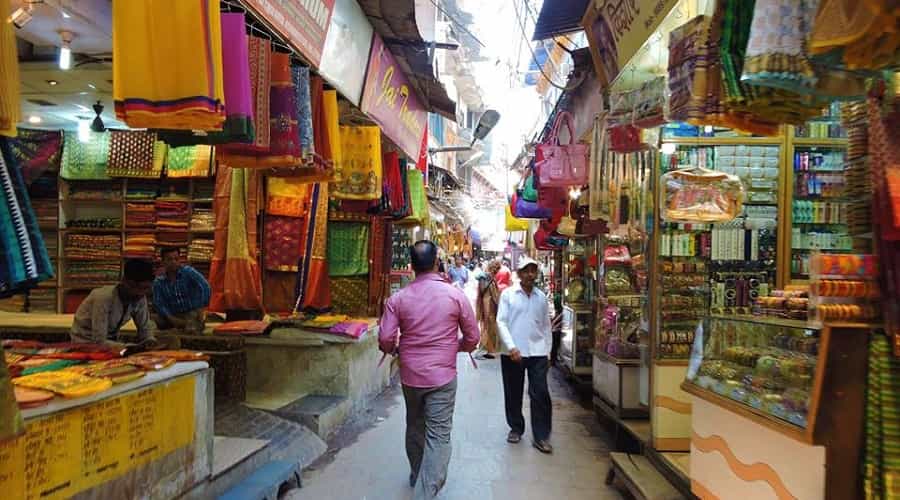
7. Tulsi Manas Mandir and Durga Kund
If you’re open to exploring a little further from the ghats, Tulsi Manas Mandir and Durga Kund Temple are worth a visit.
- Tulsi Manas Mandir: Built where poet-saint Tulsidas is believed to have composed the Ramcharitmanas. The walls are inscribed with verses, making it feel like walking inside a living scripture.
- Durga Kund Temple: Known as the Monkey Temple, this vibrant red shrine dedicated to Goddess Durga has a large pond beside it and plenty of playful monkeys around.
These temples show you another facet of Varanasi’s faith—not just Shiva, but also Rama and Durga worshipped with equal devotion.
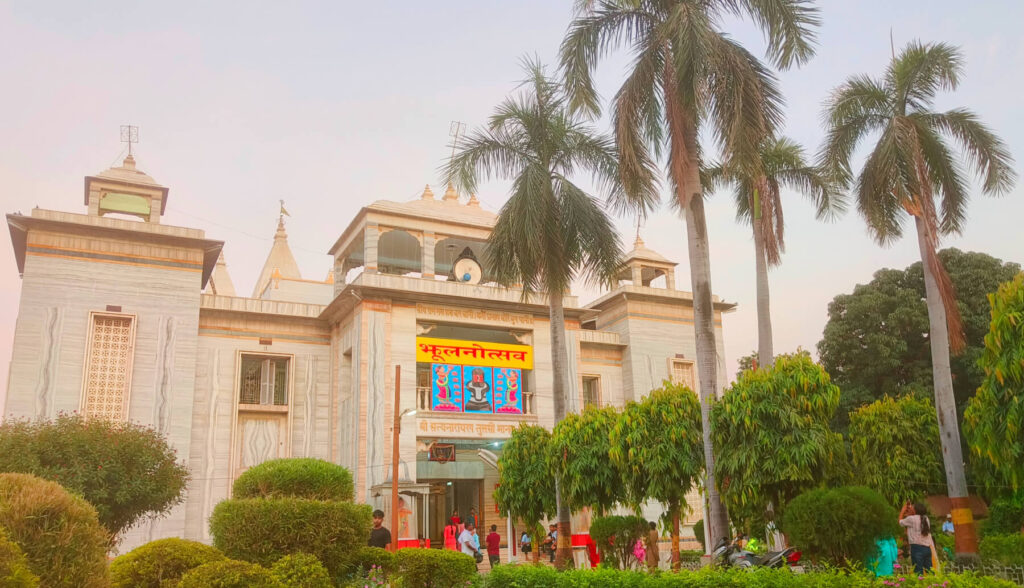
8. Banaras Hindu University (BHU) and Bharat Kala Bhavan
If you want to see the intellectual side of the city, head to BHU, one of India’s largest universities. The campus is massive, green, and calming compared to the bustle of the ghats. Within it lies the New Vishwanath Temple, a modern replica of the Kashi Vishwanath shrine.
Also within BHU is the Bharat Kala Bhavan Museum, which houses ancient sculptures, paintings, and artifacts. For anyone curious about Indian art and history, it’s a treasure chest.
Practical Travel Tips
If you’re planning a visit, here’s what I learned first-hand:
- Best Time to Visit: Early mornings are peaceful and let you avoid the rush. Evenings are beautiful but busier.
- Dress Code: Wear modest clothes—simple cottons are best for the weather and respectful for the setting.
- Offerings: You can buy flowers, bilva leaves, and sweets outside the temple. Vendors often help first-timers with the process.
- Footwear: Like all temples, you’ll leave shoes outside, so wear something easy to slip off.
- Getting There: Auto-rickshaws can take you close, but be prepared to walk through lanes. Google Maps may not capture the narrowest alleys, so ask locals—they’re always happy to guide you.
A Personal Reflection
What makes Mahamrityunjay Temple unforgettable isn’t just its legends or rituals—it’s the atmosphere of healing and reassurance. I saw people praying not just for themselves but for loved ones back home, lighting lamps with tears in their eyes and hope in their hearts.
It reminded me that temples like this aren’t about grand architecture or spectacle. They’re about connection—the simple act of trusting that your worries can be lightened when placed in divine hands.
As I stepped out of the temple, the world outside felt just as chaotic as before: noisy streets, honking rickshaws, and wandering cows. But inside me, there was a strange calm, as if I had left a part of my fears behind with the Lord of Death’s conqueror.
FAQs
Q1. Where is Mahamrityunjay Temple located?
It is located near Daranagar, in the heart of Varanasi, Uttar Pradesh.
Q2. Which deity is worshipped here?
The temple is dedicated to Lord Shiva, worshipped through the Mahamrityunjay form.
Q3. Why is the temple called Mahamrityunjay?
It is named after the Mahamrityunjay mantra, a powerful Vedic chant for health, longevity, and protection from untimely death.
Q4. What is special about the temple?
A sacred well in the temple premises is believed to have healing powers, and devotees often take its water for rituals.
Q5. Can people chant the Mahamrityunjay mantra here?
Yes, many devotees recite the mantra here daily, especially on Mondays and during Shravan month.
Q6. What are the temple timings?
The temple is open from early morning till evening with regular aarti and puja.
Q7. Is there any entry fee?
No, entry is free for all devotees.
Q8. What festivals are celebrated at the temple?
Maha Shivaratri and Shravan month see grand celebrations with thousands of devotees.
Q9. How can one reach Mahamrityunjay Temple?
It is well connected by road within Varanasi; the nearest railway station is Varanasi Junction, and the nearest airport is Lal Bahadur Shastri Airport.
Q10. What is the best time to visit the temple?
October to March is ideal for comfortable weather, while Shravan month is best for a spiritual experience.

